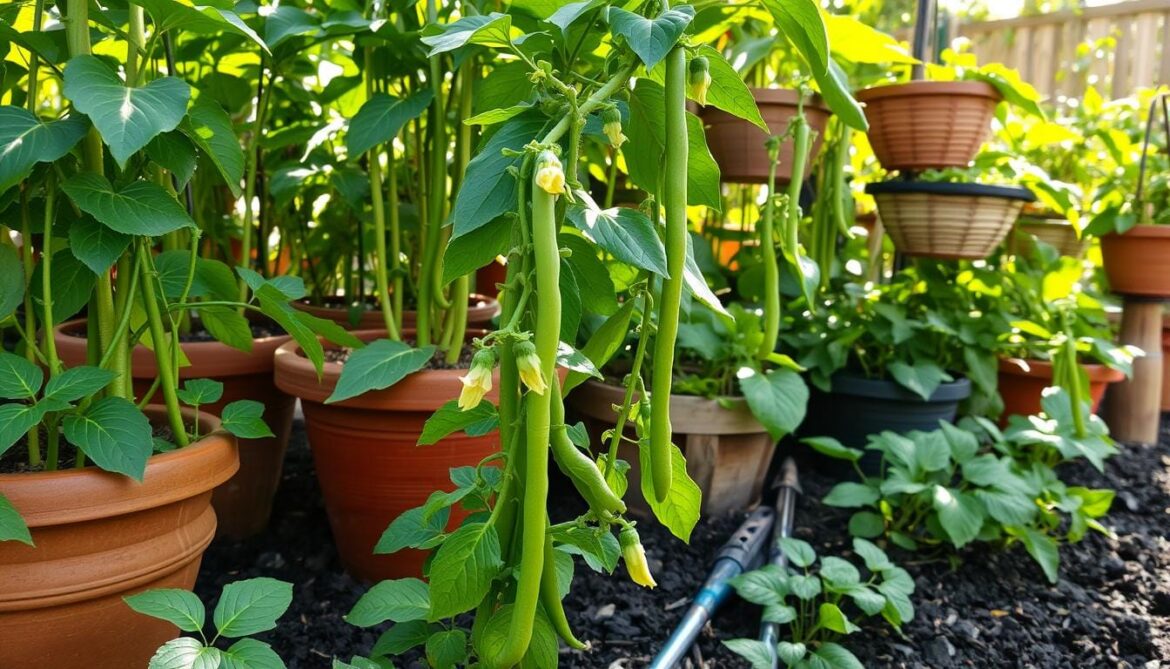Growing your own food is a joy. But what if you don’t have much space? Don’t worry, growing green beans in containers is easy and rewarding. It brings fresh produce right to your door, no matter if you have a small patio, balcony, or tiny backyard.
Container gardening for green beans is a great choice for those with little space. These plants do well in small areas, perfect for city living, apartments, or small gardens. With some knowledge and the right steps, you can enjoy fresh, tasty green beans from your home.
Key Takeaways
- Green beans can be successfully grown in containers, even with limited space.
- Container gardening for green beans is a practical and affordable option for urban and small-space gardeners.
- Proper selection of container size, soil, and sunlight requirements are key to growing healthy, productive green bean plants.
- Green beans come in two main varieties – bush beans and pole beans – with different growth habits and planting needs.
- Careful attention to watering, fertilizing, and pest management will ensure a bountiful green bean harvest.
Why Grow Green Beans in Containers?
Container gardening for green beans opens up a world of benefits. It’s perfect for city folks or those with tiny outdoor spots. You can tweak the soil and protect the roots. Plus, you can adjust sunlight and water easily.
Benefits of Container Gardening
- Easily manage soil quality and nutrient levels for optimal plant growth.
- Protect plants from pests and diseases more effectively in a contained environment.
- Extend the growing season by moving containers indoors or to sheltered areas when needed.
- Enjoy a bountiful harvest of fresh, flavorful green beans right at your fingertips.
Ideal for Limited Space
Container gardening is a lifesaver for those with small outdoor areas. By picking compact green bean varieties, you can make the most of your space. Hestia, a dwarf runner bean, is a top pick, reaching 12-14 inches tall and fitting small gardens well.
Accessibility for All Gardeners
Container gardening is also great for those with mobility issues. Raised beds or planters make gardening easier, without the need for bending or kneeling. It lets everyone grow their own green beans, no matter their physical abilities.
“Gardening is a great way to spend time outdoors, get exercise, and enjoy the fruits of your labor. Container gardening makes it accessible for everyone, regardless of their space or physical abilities.”
Choosing the Right Container for Green Beans
When growing green beans in containers, the container’s size and material matter a lot. The right one provides the needed space and drainage for your beans to grow well.
Size Matters: Container Dimensions
For bush beans, choose a container at least 6 inches deep. For pole beans, go for 9 inches deep. This depth lets the roots spread and get the nutrients they need. Also, think about the container’s width, as it affects how many plants you can grow. Plant each bean about 5-6 inches apart.
A 5-gallon grow bag is great for about a dozen green bean seeds. It gives them enough room to grow. Fabric grow bags are also good because they let air and water flow well around the roots.
Materials: Plastic, Ceramic, and Fabric
Think about the container’s material. Plastic is light, durable, and cheap, making it a favorite for gardening. Ceramic pots are pretty and keep the soil temperature right. Fabric grow bags are best for drainage and air flow.
Pole beans get tall, so use heavy, wide pots to keep them stable. Raised beds are also great for climbing beans. They give lots of room for the beans to grow and are easy to care for.
Drainage Features to Consider
All containers need drainage holes to avoid waterlogged soil and root rot. Good drainage is key for green beans to grow well. Add gravel or drainage material at the bottom to help with drainage and air.
Choosing the right container size, material, and drainage features will help your green beans thrive. This ensures a good harvest and a healthy container garden.
Selecting the Best Green Bean Variety
Choosing between bush beans and pole beans can greatly affect your container garden. Each variety has unique traits that fit different climates and gardening styles. Knowing these differences helps pick the perfect green beans for your space.
Bush Beans vs. Pole Beans
Bush beans grow up to 2 feet tall and don’t need much support. They’re great for small pots because they grow fast and produce a lot in a short time. On the other hand, pole beans need something to climb on but keep producing beans for longer.
Recommended Varieties for Containers
- ‘Kentucky Wonder’: An heirloom pole bean variety known for its disease resistance and exceptional flavor.
- ‘Tavera Filet’: A French-style bush bean that produces tender, slender pods perfect for container gardens.
- ‘Trionfo Violetto’: An Italian heirloom pole bean with stunning purple-colored pods.
Local Climate Considerations
It’s crucial to pick green bean varieties that match your local climate. Some beans handle heat or cold better than others. Make sure to choose varieties that fit your USDA Hardiness Zone for a successful harvest.
“Green beans are not only delicious but also highly nutritious, packed with protein, vitamins, and minerals. Choosing the right variety can make all the difference in your container garden’s success.”
Soil Requirements for Healthy Growth
Growing green beans in containers needs careful soil attention. These legumes [https://chikusgarden.com/golden-blooms-exploring-the-beauty-of-yellow-peonies-in-your-garden/] do well in slightly acidic to neutral soil. A pH range of 6 to 7 is best. Using a high-quality potting mix is key for their growth.
Importance of Quality Potting Mix
For container green beans, a loamy potting mix with good drainage is best. Stay away from sandy soil, which drains too fast. Also, avoid heavy clay soils that can waterlog. Adding well-rotted compost or manure improves soil quality and adds nutrients.
Soil Amendments to Enhance Growth
- For container gardening, use a fresh potting soil blend with vermiculite or perlite. This improves moisture retention and nutrient release.
- Keep an eye on the soil pH and adjust it if needed. The ideal range is 6 to 7 for green beans.
- Add organic matter like compost or aged manure. It enriches the soil and helps plants grow strong.
Maintaining pH Levels
Keeping the soil pH consistent is vital for green bean success. Check pH levels often and adjust as needed. This ensures the best potting mix for green beans and the right soil pH for green beans. With the right soil, your green beans will thrive.
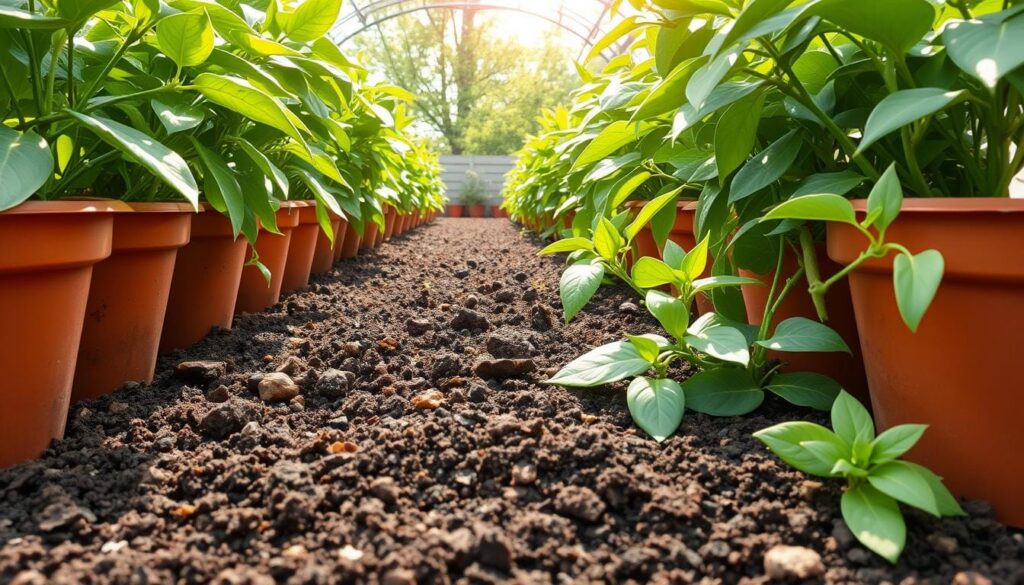
Sunlight Needs for Optimal Growth
To get lush green beans, knowing their sunlight needs is key. Green beans love spots with 4-5 hours of direct sun a day. Morning sun is best because it’s not too strong.
They can handle some shade, but they won’t grow as well as in full sun. For more info, check out this link.
Finding the Perfect Location
Choose a spot for your green beans that shields them from strong afternoon sun. This helps them grow longer and avoid stress. If your plants have lots of leaves but few flowers, move them to a sunnier spot.
Understanding Sunlight Requirements
- Green beans need 4-5 hours of direct sunlight a day for best growth and production.
- They can handle some shade, but they won’t produce as much as in full sun.
- Shielding them from intense afternoon sun can extend their growing season.
Adjusting for Seasonal Changes
As seasons change, you might need to move your green bean containers to keep them in the right sunlight. Watch your plants and move them as needed. This ensures they get the right amount of sunlight all season.
By managing their light, you create the best spot for your green beans to grow well.
| Sunlight Requirement | Optimal Conditions | Partial Shade Impact |
|---|---|---|
| Direct Sunlight | 4-5 hours per day | Reduced Yield |
| Morning Sun | Preferred | N/A |
| Afternoon Sun | Needs Protection | Premature Plant Stress |
By understanding the sunlight needs of green beans, gardeners can make the best conditions. This leads to a great harvest.
Planting Green Beans in Containers
Growing how to plant green beans in pots is rewarding, even with little space. You can enjoy fresh, tasty green beans from your container garden. Just use the right planting methods.
Proper Planting Techniques
Start planting your green bean planting season seeds when it’s 55°F outside. The air should be between 65°F-85°F. Plant the seeds 1 inch deep.
Space bush bean varieties 2 inches apart. Later, thin them to 6 inches. For pole beans, set up supports first and plant seeds around them.
Spacing Guidelines for Different Varieties
Spacing for green beans depends on the variety. Bush beans need 2 inches between each plant. Pole beans require 6-12 inches.
Thin bush bean seedlings to the right spacing as they grow. This ensures they have enough room to develop.
Best Time to Plant in the US
In the US, plant green beans in the spring after the last frost. This is usually in April or May, based on your area’s climate. You can also plant in August for a fall harvest.
Water the seeds right after planting to help them grow.
“Succession planting by sowing new seeds every two to three weeks can provide a continuous harvest of green beans throughout the growing season.”
By following these tips and knowing your green bean variety’s needs, you’ll have a thriving container garden. Enjoy growing your own how to plant green beans in pots! Happy planting!
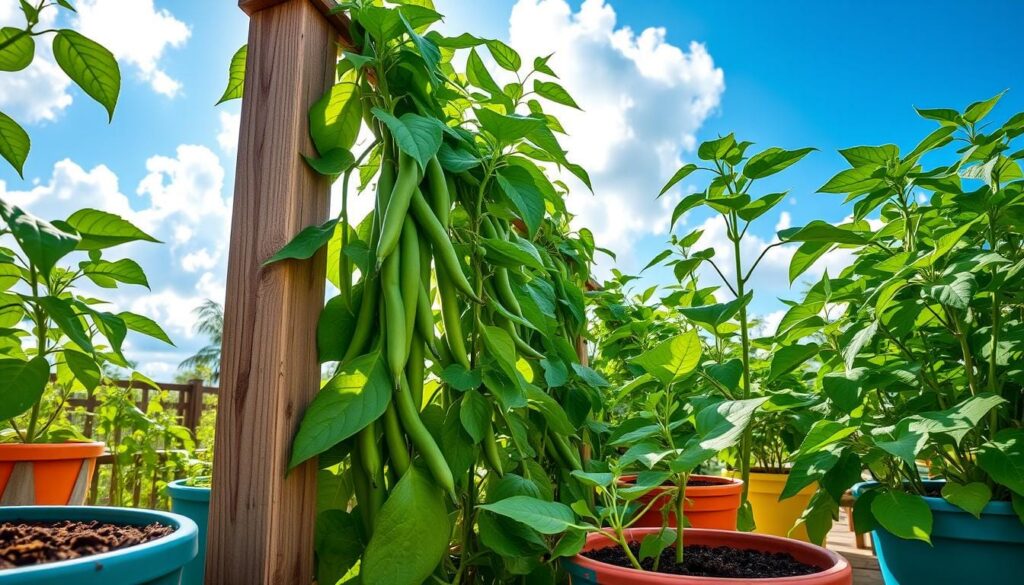
Watering Your Container Grown Green Beans
Keeping the soil moist is key for growing green beans in containers. These plants need about 1 to 1.5 inches of water each week. This includes rain. Keeping the soil moist but not too wet helps avoid problems like flower drop and fungal diseases.
Understanding Watering Needs
Green beans in containers need careful attention to their water needs. In hot, dry weather, they lose water fast. Water them slowly and deeply to reach 6 to 8 inches down. This helps their roots grow strong, which is vital for healthy plants.
Signs of Over and Underwatering
Check the soil moisture by feeling it with your finger. Water when the top inch feels dry. But watch out for too much water, which can cause root rot. If the leaves wilt or plants look stunted, they might not be getting enough water.
Best Practices for Effective Watering
- Use a drip irrigation system or water at the base to avoid wetting leaves, which can lead to disease.
- Think about using self-watering containers to keep the soil moist evenly and prevent over or underwatering.
- Change how often you water based on the weather, soil type, and how the plant is growing, as needs change over time.
By following these watering tips for container-grown green beans, you can make sure they get the right amount of water. This will help them grow well and give you a good harvest.
Fertilizing Green Beans: What You Need to Know
When growing green beans in containers, fertilizing them right is key. Green beans can take nitrogen from the air, so they don’t need a lot of fertilizer. But, they do benefit from a potassium boost in the middle of the season.
Choosing the Right Fertilizer
Choose a fertilizer low in nitrogen, like a 5-10-10 formula. This helps prevent too much leaf growth and keeps the focus on beans. Adding high-quality compost on top of the soil gives your beans the nutrients they need. For a greener option, try compost tea or well-rotted manure.
When and How to Fertilize
Feed your green beans with fertilizer every month. Use it in liquid or granular form to keep nutrients flowing. But don’t overdo it, too much nitrogen can hurt bean production and plant health.
Organic Options for Eco-Friendly Gardening
For a green gardening approach, organic fertilizers like compost tea or manure are great. These organic fertilizers for beans give nutrients slowly, helping soil health and protecting the environment.
“Fertilizing your green beans, whether with synthetic or organic options, is a crucial step in ensuring a bountiful harvest. By understanding the right balance and timing, you can set your container-grown beans up for success.”
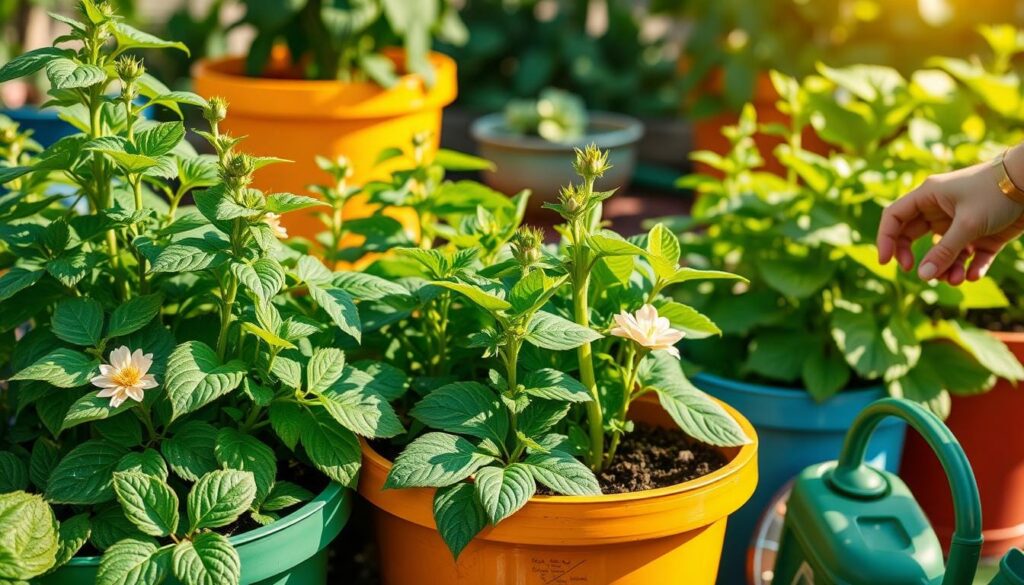
Supporting Tall Pole Beans
Growing pole beans in containers is a challenge. They need support for their tall vines. But, there are many ways to help them climb high and give you lots of beans.
Types of Supports to Use
There are many supports for your pole beans, like trellises, bamboo teepees, or tomato cages. Pick one that’s strong and tall enough for your beans.
DIY Support Structures
- Make a teepee with bamboo poles tied at the top.
- Build a trellis by attaching mesh or lattice to your container.
- Use a tripod for wooden or metal poles to support your beans.
Maintaining Stability as Beans Grow
It’s important to anchor your support well to the container. This keeps it from falling as your beans grow. Check your supports often and adjust them as needed.
With the right trellis for pole beans in containers and DIY bean supports, your pole beans will thrive. They’ll give you a big harvest.
Pest Management for Container Gardens
Keeping a container garden healthy means watching out for pests. Common pests include bean leaf beetles, aphids, leafhoppers, whiteflies, and thrips. It’s important to check for signs of pests early to stop problems.
Common Pests to Watch For
- Bean leaf beetles: These pests eat leaves and pods, leaving holes.
- Aphids: These tiny insects suck sap, causing plants to grow slowly.
- Leafhoppers: These insects jump and can spread diseases, slowing plant growth.
- Whiteflies: These flying pests eat leaves from below, causing yellowing and wilting.
- Thrips: These slender insects damage leaves and can spread deadly viruses.
Organic Pest Control Solutions
For green bean pests, we choose organic pest control. Natural methods include picking pests by hand, using insecticidal soap, neem oil, or pyrethrin for tough cases. Adding beneficial insects like ladybugs and lacewings helps too.
Preventive Measures We Can Take
To stop green bean pests before they start, use row covers and keep plants healthy. Encourage beneficial insects. For aphids, a soap solution works well. Proper spacing helps air flow, making it harder for pests to get to plants. By using organic pest control for container gardens, we protect our green beans and pollinators.
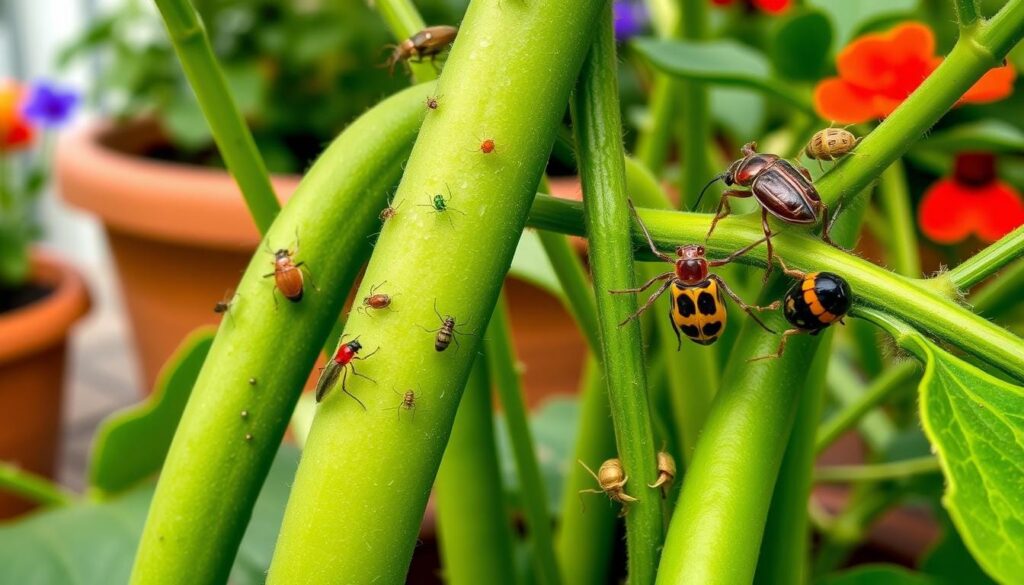
“The best defense against pests in a container garden is a healthy, thriving plant.”
Disease Prevention and Management
Keeping your garden healthy starts with fighting off common green bean diseases. Spotting signs early and using organic fixes helps our container-grown green beans grow well all season.
Recognizing Common Bean Diseases
Green beans often face bean rust, bean common mosaic virus, powdery mildew, and white mold. Bean rust shows up as reddish-brown spots on leaves. The mosaic virus makes leaves look mottled and discolored.
Powdery mildew covers leaves in a white, powdery film. White mold causes stems and pods to rot.
Organic Remedies for Prevention
- Make sure plants have good air flow to stop fungi.
- Don’t water from above to avoid spreading diseases.
- Choose bean varieties that resist disease.
- Try a baking soda spray (1 tsp per quart of water) for powdery mildew.
- Quickly remove and destroy sick plants to stop disease spread.
- Rotate crops and keep your garden clean.
When to Seek Professional Help
If diseases keep coming back or spreading fast, get help. Talk to a local extension office or a skilled gardener. They can give you specific advice on organic disease control for beans and help you make a plan to protect your green beans.
By watching closely and using organic prevention, we can keep our green beans healthy and productive all season.
Harvesting Green Beans for Peak Flavor
Getting the most out of our container-grown green beans means paying close attention to when to pick them. The key is to harvest at the perfect time. We aim for beans that are firm, crisp, and full-sized, but not yet bulging with seeds.
Signs That Beans Are Ready to Be Harvested
Most green beans are ready when they’re about 4 inches long. But, it’s smart to check the specific growing instructions for your variety. Bush beans usually produce all their beans in 2-4 weeks. Pole beans, on the other hand, keep giving beans all season long. It’s crucial to pick them often to keep the quality high.
Best Practices for Harvesting
- Harvest your green beans in the morning when they’re at their best.
- Use two hands to gently snap the pod off the plant without harming it.
- Regularly picking beans encourages the plants to keep producing.
Post-Harvest Storage Tips
After picking your green beans, it’s vital to store them right to keep them fresh and tasty. Here are a few tips for storing fresh green beans:
- Keep unwashed beans in a perforated plastic bag in the fridge for up to a week.
- For longer storage, blanch and freeze the beans. This keeps their texture and taste.
By following these tips on when to harvest green beans and storing fresh green beans, you’ll get the best flavor from your container-grown crop.
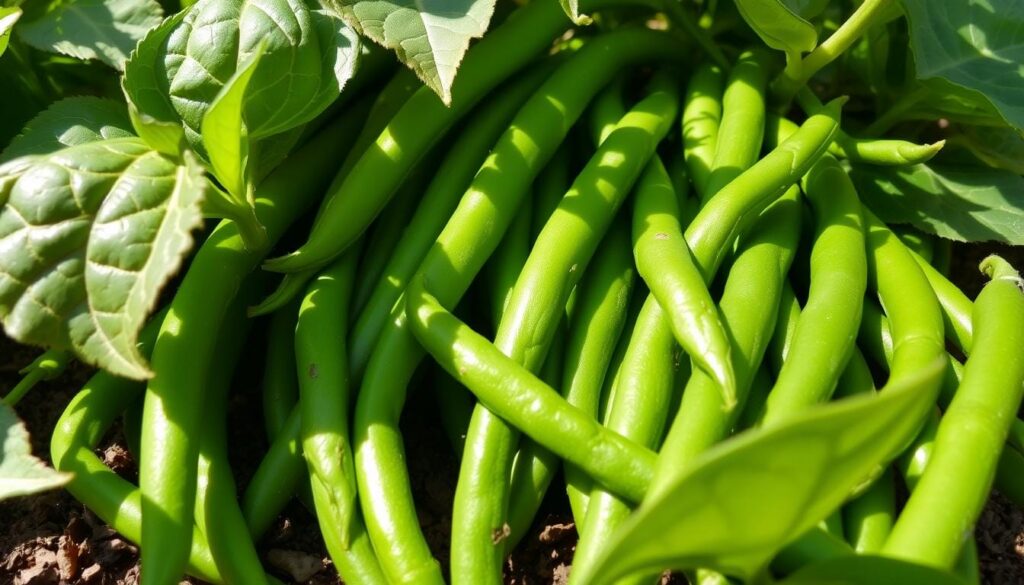
Troubleshooting Common Issues
Growing green beans in containers can be tricky. We might face problems like yellow leaves, slow growth, and blossom drop. But don’t worry! We can fix these issues and get our plants growing well again.
Yellowing Leaves: Causes and Solutions
Yellow leaves on green beans can mean a few things. It might be because of not enough nutrients or too much water. We can fix this by using the right fertilizer and watering less.
Pests could also cause yellow leaves. So, we need to check our plants for any unwanted guests and treat them if needed.
Stunted Growth: Possible Reasons
Slow-growing green beans might have a few reasons. Bad soil, not enough sunlight, or nematodes can all slow them down. We should use good potting mix, give them lots of sunlight, and test the soil.
Dealing with Blossom Drop
Blossom drop is a big problem for container green beans. It’s often caused by too much heat or cold, or uneven watering. To stop it, we need to keep our plants cool and water them evenly.
We should also manage pests and choose varieties that resist blossom drop. This way, we can have a great harvest and enjoy our hard work.
Enjoying the Fruits of Our Labor
After taking care of our green bean plants, it’s time to enjoy the fruits of our labor. Our homegrown green beans can be enjoyed in many delicious ways. They show off their fresh, vibrant flavors.
Cooking with Fresh Green Beans
Our green beans are great for steaming, sautéing, or salads. The trick is to cook them just right, so they stay tender-crisp. A simple seasoning of salt, pepper, and butter or olive oil brings out their garden-fresh taste.
Preserving Beans for Future Use
We can keep enjoying our green beans by preserving them. Blanching and freezing is a great way to keep their color, texture, and nutrients. Pickling is another option, making tasty, shelf-stable jars of green beans. Whether frozen or pickled, our green beans will remind us of summer long after it’s gone.
Sharing Our Bounty with Friends and Family
One of the best things about growing green beans in containers is sharing them. We can swap our green beans for other homegrown produce. Giving bags of fresh beans to neighbors or donating to food banks is also a great way to share. Celebrating our green bean success is best done by sharing it with loved ones.
